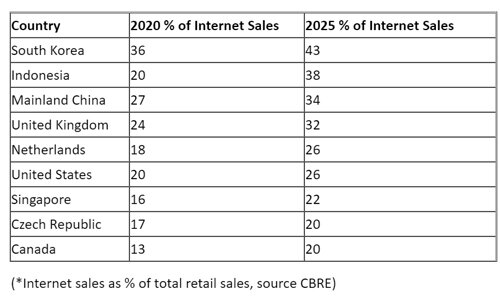Commercial Real Estate News

Global E-commerce Growth Needs 1.5 Billion Square Feet of New Distribution Space
Commercial News » Seoul Edition | By Michael Gerrity | August 19, 2021 8:53 AM ET
U.S. alone needs 330 million sq. ft. of new warehouse space by 2025
According to international property consultant CBRE, e-commerce penetration is expected to grow to 26 percent of all retail sales by 2025, the U.S. will need an additional 330 million sq. ft. of distribution space just to handle the increase in online ordering in that timeframe.
That anticipated, e-commerce-generated demand for another 330 million sq. ft. of distribution space represents 27 percent of the projected overall demand for industrial real estate in the U.S. through 2025, according to CBRE Econometric Advisors. The broader category of industrial real estate includes warehouses for traditional retail distribution, manufacturing, R&D space and data centers.
CBRE forecasted the incremental demand based on its estimate that every additional $1 billion of e-commerce sales requires 1 million sq. ft. of new distribution space. According to CBRE's forecast, which is based on Euromonitor data for 2020, U.S. e-commerce sales are expected to increase $330B from 2020 to 2025. Globally, e-commerce sales are forecast to rise by $1.5 trillion in this same time period, requiring an additional 1.5 billion sq. ft. of warehouse/distribution space to accommodate this growth. The U.S. and Mainland China are the biggest e-commerce markets in the world, accounting for 57 percent of global Internet sales.
"E-commerce has grown steadily over the years, and it will continue at a strong pace for the foreseeable future," said John Morris, Executive Managing Director and Leader of CBRE's Americas Industrial & Logistics and Retail businesses. "As a result, distribution and supply chain networks will continue to be under pressure to meet demand at a time when industrial vacancy is at record low levels. A significant amount of new construction will be needed in the next few years just to keep pace with robust demand."
According to the CBRE report, South Korea is forecast to have the world's highest e-commerce penetration in 2025 at 43 percent. The U.S. will be one of the top 10 markets globally for e-commerce penetration in 2025. To forecast growth, CBRE looked at such drivers as each country's percentage of urban population, debit and credit card use, the population's digital skills and digital technology infrastructure.
"While there is a sizable construction pipeline in the U.S., much of that new space already is leased to meet the demand of the past few years," said James Breeze, Senior Director and Global Head of Industrial & Logistics Research for CBRE. "Moving forward, the challenge in many U.S. and global markets will be to produce enough new facilities to meet this rapidly expanding market. It's important to bear in mind that e-commerce is only a portion of the overall demand for distribution facilities. Traditional retailers, third party logistics companies and others will also be demand catalysts. If developers can't build facilities fast enough, we could see rental rates push well beyond their current record highs."

Sign Up Free | The WPJ Weekly Newsletter
Relevant real estate news.
Actionable market intelligence.
Right to your inbox every week.
Real Estate Listings Showcase
Related News Stories
Commercial Real Estate Headlines
- U.S. Commercial Mortgage Delinquencies Rise in Q2, CMBS Loans Lead the Surge
- Tokenization-Focused Real Estate Investment Bank Announced
- Commercial Cap Rates Edge Lower in U.S., Hinting at Market Turn
- WPV Targets New $6 Trillion Digital Real Estate Tokenization Opportunity
- $1 Trillion in Data Center Development Underway Through 2030
- WORLD PROPERTY VENTURES: The 'Anti-VC' of Real Estate Plans Major Capital Raise
- Multifamily Sector Enjoys Record Absorption in U.S. as Supply Slows, Vacancies Drop
- Employee Back-to-Office Attendance Surges in U.S.
- Phnom Penh Commercial Property Sectors Face Crosswinds in 2025
- World Property Bank Announced to Capitalize on Coming Trillion-Dollar Tokenization Boom
- REAL ESTATE PREDICTIONS: Decentralized Events Contract Exchange in Development
- U.S. Architecture Billings Improve Slightly in May
- Tokyo Office Demand Spills into Non-Core Wards in 2025
- AI Hyperscalers Drive Record Data Center Leasing in Early 2025
- Commercial, Multifamily Mortgage Debt in U.S. Hits Record $4.81 Trillion in Early 2025
- U.S. Multifamily Market Rebounds in Early 2025
- U.S. Office Market Experiences Historic Conversion Shift
- New York City Enters New Era of Office-to-Residential Conversions
- World Property Ventures Plans New Capital Raise
- U.S. Commercial Real Estate Lending Rebounds Sharply in Early 2025
- U.S. Multifamily Housing Confidence Declines in Early 2025
- Asia Pacific Commercial Investment Holds Steady in Early 2025
- Carnival Plans New Miami Headquarters Spanning Over 600,000 Square Feet
- Hong Kong Property Investors Take a Wait-and-See Approach Due to U.S. Tariffs
- U.S. Multifamily Buyer and Seller Sentiment Improves in Early 2025
- One Trillion Dollars of America's Commercial Property Loans Mature in 2025
- U.S. West Coast Dominates Self Storage Demand
- Phoenix, Orange County and Inland Empire Emerge as Leading U.S. Industrial Markets
- U.S. Mega Distribution Centers Leasing Activity Grew in 2024
- U.S. Commercial Borrowing to Increase to $583 Billion in 2025, Up 16 Percent Annually
- Demand for U.S. Life Sciences Space Spikes 28 Percent Annually in Late 2024
- Multifamily Property Sector in America Rebounding
- Asia Pacific Commercial Property Investment Spikes 23 Percent in 2024
- U.S. Commercial Property Market Primed for Growth in 2025
- Architecture Industry Sees Mixed Signals as 2025 Approaches
- Global Data Center Demand Spikes in 2025
- 2025 Prediction: U.S. Commercial Investment Recovery Expected to Gain Traction
- Holiday Retail Sales for 2024 to Hit Record $1 Trillion
- Tech, AI Industries Drive Largest Share of Office Leasing Activity in U.S.
- Commercial Real Estate Lending in U.S. Enjoys Strong Growth in Q3







